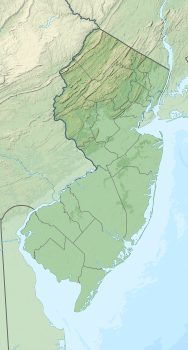|
Lakewood (CDP), New Jersey
Lakewood is an unincorporated community and census-designated place (CDP)[9] located within Lakewood Township, in Ocean County, in the U.S. state of New Jersey.[10][11][12][13] As of the 2010 United States Census, the CDP's population was 53,805.[14] GeographyAccording to the United States Census Bureau, the CDP had a total area of 7.323 square miles (18.97 km2), including 7.078 square miles (18.33 km2) of land and 0.245 square miles (0.63 km2) of water (3.35%).[5][15] Demographics
2010 censusThe 2010 United States census counted 53,805 people, 10,592 households, and 8,918 families in the CDP. The population density was 7,601.8 people per square mile (2,935.1 people/km2). There were 11,226 housing units at an average density of 1,586.1 units per square mile (612.4 units/km2). The racial makeup was 85.79% (46,160) White, 4.75% (2,556) Black or African American, 0.28% (149) Native American, 0.50% (270) Asian, 0.03% (14) Pacific Islander, 7.41% (3,986) from other races, and 1.25% (670) from two or more races. Hispanic or Latino of any race were 17.74% (9,546) of the population.[14] Of the 10,592 households, 62.7% had children under the age of 18; 70.5% were married couples living together; 9.3% had a female householder with no husband present and 15.8% were non-families. Of all households, 12.6% were made up of individuals and 6.5% had someone living alone who was 65 years of age or older. The average household size was 4.89 and the average family size was 5.23.[14] 48.4% of the population were under the age of 18, 12.7% from 18 to 24, 25.4% from 25 to 44, 9.1% from 45 to 64, and 4.3% who were 65 years of age or older. The median age was 19.1 years. For every 100 females, the population had 106.8 males. For every 100 females ages 18 and older there were 107.2 males.[14] 2000 censusAs of the 2000 United States Census,[6] there were 36,065 people, 8,984 households, and 6,971 families living in the CDP. The population density was 1,944.8 people/km2 (5,037 people/sq mi). There were 9,496 housing units at an average density of 512.1 units/km2 (1,326 units/sq mi). The racial make-up of the CDP was 77.64% White, 12.24% African American, 0.20% Native American, 0.96% Asian, 0.04% Pacific Islander, 5.55% from other races, and 3.37% from two or more races. Hispanic or Latino of any race were 17.69% of the population.[19] There were 8,984 households, out of which 49.7% had children under the age of 18 living with them, 60.3% were married couples living together, 13.0% had a female householder with no husband present, and 22.4% were non-families. 18.2% of all households were made up of individuals, and 10.1% had someone living alone who was 65 years of age or older. The average household size was 3.83 and the average family size was 4.36.[19] In the CDP, the population was spread out, with 41.4% under the age of 18, 13.0% from 18 to 24, 25.7% from 25 to 44, 11.7% from 45 to 64, and 8.3% who were 65 years of age or older. The median age was 23 years. For every 100 females, there were 101.6 males. For every 100 females age 18 and over, there were 99.7 males.[19] The median income for a household in the CDP was $30,769, and the median income for a family was $32,748. Males had a median income of $35,672, versus $24,265 for females. The per capita income for the CDP was $11,802. About 26.4% of families and 29.1% of the population were below the poverty line, including 34.0% of those under age 18, and 18.5% of those age 65 or over.[19] References
|
||||||||||||||||||||||||||||||||||||||||||||||||||||||||||||||||||||||||||||||||||||||




